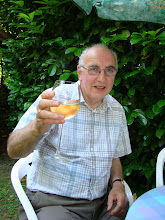 Penny-farthing, high wheel, high wheeler and ordinary are all terms used to describe a type of bicycle with a large front wheel and a much smaller rear wheel that was popular after the velocipede, or boneshaker, until the development of the safety bicycle. They were the first machines to be called bicycles. Although they are now most commonly known as 'penny-farthings', this term was not used until well after they became outdated - the first print reference is 1927. (It comes from the British penny and farthing coins, one much larger than the other so that the side view resembles a penny leading a farthing), and for most of their reign in they were simply known as 'bicycles'. In the late 1890s the retronym 'ordinary' began to be used, to distinguish them from safety bicycles.
Penny-farthing, high wheel, high wheeler and ordinary are all terms used to describe a type of bicycle with a large front wheel and a much smaller rear wheel that was popular after the velocipede, or boneshaker, until the development of the safety bicycle. They were the first machines to be called bicycles. Although they are now most commonly known as 'penny-farthings', this term was not used until well after they became outdated - the first print reference is 1927. (It comes from the British penny and farthing coins, one much larger than the other so that the side view resembles a penny leading a farthing), and for most of their reign in they were simply known as 'bicycles'. In the late 1890s the retronym 'ordinary' began to be used, to distinguish them from safety bicycles.About 1870, James Starley, described as the father of the bicycle industry, and others began producing bicycles based on the French boneshaker but with front wheels of increasing size, because larger front wheels, up to 1.5 m (60 in) in diameter, enabled higher speeds on bicycles limited to direct drive. Although the trend was short-lived, the penny-farthing became a symbol of the late Victorian era. Its popularity also coincided with the birth of cycling as a sport.
Frenchman Eugene Meyer is now regarded as the father of the High Bicycle by the International Cycling History Conference in place of James Starley. Meyer patented a wire-spoke tension wheel with individually adjustable spokes in 1869. They were called 'spider' wheels in Britain when introduced there. Meyer produced a classic high bicycle design until the 1880s
James Starley in Coventry added the tangent spokes and the mounting step to his famous bicycle named 'Ariel'. He is regarded as the father of the British cycling industry. Ball bearings, solid rubber tires and hollow-section steel frames became standard, reducing weight and making the ride much sm
 oother.
oother.Bicycling remained the province of the urban well-to-do, and mainly men, until the 1890s and were among the first examples of conspicuous consumption.
The nephew of one of the men responsible for popularity of the penny-farthing was largely responsible for its death. At a time of innovation chain drives were upgraded and higher speeds were achieved without the large wheel. In 1885, Starley's nephew John Kemp Starley took these new developments to launch the 'Rover Safety Bicycle', so called because the rider, seated much lower and farther behind the front wheel contact point, was less prone to "a header."
In 1888, John Dunlop reinvented the pneumatic tire, adding comfort to the new safety bicycles. By 1893 high-wheelers were no longer being produced.




